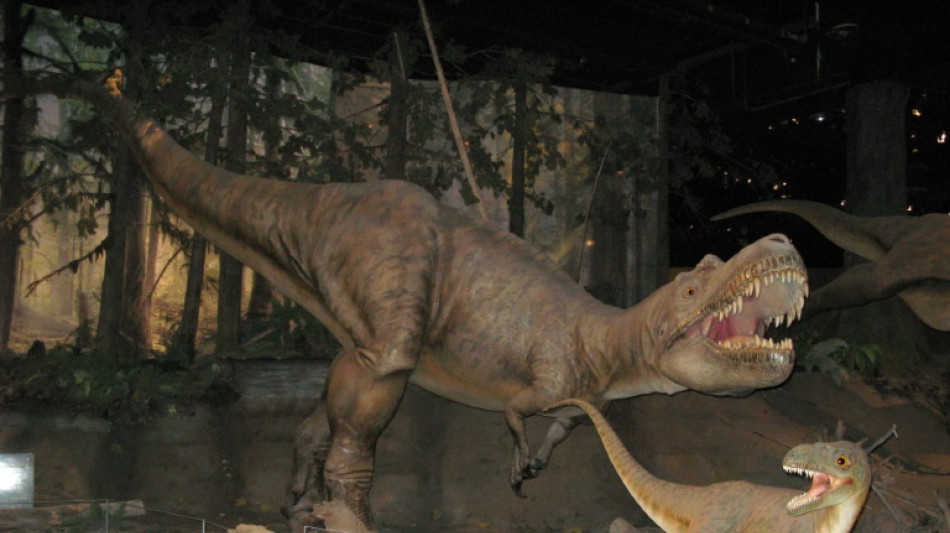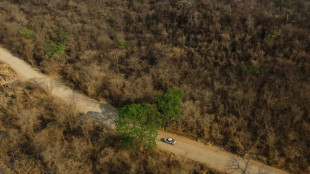
-
 US writes off over $1 billion of Somalia debt
US writes off over $1 billion of Somalia debt
-
Stock markets climb, dollar dips as US votes

-
 Boeing union approves contract, ending over 7-week strike
Boeing union approves contract, ending over 7-week strike
-
Stock markets rise, dollar falls as US votes

-
 US September trade deficit widest in over two years
US September trade deficit widest in over two years
-
'Black day': French workers protest Michelin plans to close two plants

-
 Saudi Aramco's quarterly profit drops 15% on low oil prices
Saudi Aramco's quarterly profit drops 15% on low oil prices
-
Spain unveils aid plan a week after catastrophic floods

-
 Europe auto struggles lead to cuts at Michelin, Germany's Schaeffler
Europe auto struggles lead to cuts at Michelin, Germany's Schaeffler
-
Norway speeds ahead of EU in race for fossil-free roads

-
 Most Asian markets rise as US heads to polls in toss-up vote
Most Asian markets rise as US heads to polls in toss-up vote
-
Nintendo lowers sales forecast as first-half profits plunge

-
 Most Asian markets rise ahead of toss-up US election
Most Asian markets rise ahead of toss-up US election
-
Saudi Aramco says quarterly profit drops 15% on low oil prices

-
 Boeing union says approves contract, ending over 7-week strike
Boeing union says approves contract, ending over 7-week strike
-
New Hampshire hamlet tied in first US Election day votes

-
 China's premier 'fully confident' of hitting growth targets
China's premier 'fully confident' of hitting growth targets
-
Asian markets swing ahead of toss-up US election

-
 Turkey sacks 3 mayors on 'terror' charges, sparking fury in southeast
Turkey sacks 3 mayors on 'terror' charges, sparking fury in southeast
-
Prince William plays rugby on S.Africa climate prize visit

-
 Striking workers weigh latest Boeing contract offer
Striking workers weigh latest Boeing contract offer
-
Montreux Jazz Festival hails 'godfather' Quincy Jones

-
 Stock markets hesitant before knife-edge US election
Stock markets hesitant before knife-edge US election
-
'War ruined me': Lebanon's farmers mourn lost season

-
 Stock markets rise before knife-edge US election
Stock markets rise before knife-edge US election
-
Eight on trial over French teacher's 2020 beheading

-
 Ryanair profit falls, growth hit by Boeing delays
Ryanair profit falls, growth hit by Boeing delays
-
Quincy Jones, entertainment titan and music mastermind

-
 Most markets rise ahead of US vote, China stimulus meeting
Most markets rise ahead of US vote, China stimulus meeting
-
Most Asian markets rise ahead of US vote, China stimulus meeting

-
 Climate finance billions at stake at COP29
Climate finance billions at stake at COP29
-
Nations gather for crunch climate talks in shadow of US vote

-
 Asian markets rise ahead of US election, Chinese stimulus meeting
Asian markets rise ahead of US election, Chinese stimulus meeting
-
No need to tell your husband: Harris banks on women's votes

-
 Striking Boeing workers set to vote on latest offer
Striking Boeing workers set to vote on latest offer
-
Pakistan shuts primary schools in Lahore over record pollution

-
 Fading literature: Delhi's famed Urdu Bazaar on last legs
Fading literature: Delhi's famed Urdu Bazaar on last legs
-
Green shoots spring from ashes in Brazil's fire-resistant savanna

-
 Serbia to demolish 'German' bridge amid outcry
Serbia to demolish 'German' bridge amid outcry
-
War decimates harvest in famine-threatened Sudan

-
 Nuts! NY authorities euthanize Instagram squirrel star
Nuts! NY authorities euthanize Instagram squirrel star
-
Nvidia to join Dow Jones Industrial Average, replacing Intel

-
 US stocks rebound on Amazon results ahead of Fed, election finale
US stocks rebound on Amazon results ahead of Fed, election finale
-
Wall Street bounces while oil prices climb on Middle East worries

-
 For a blind runner, the New York marathon is about 'vibrations'
For a blind runner, the New York marathon is about 'vibrations'
-
Wall Street bounces while oil prices gain on geopolitical fears

-
 ExxonMobil profits dip as it gives back almost $10 bn to investors
ExxonMobil profits dip as it gives back almost $10 bn to investors
-
Global stocks diverge, oil prices gain on geopolitical fears

-
 On Belgian coast, fishing on horseback -- and saving a tradition
On Belgian coast, fishing on horseback -- and saving a tradition
-
French brushmakers stage 'comeback' with pivot to luxury market


'Appetite for drumsticks': First prey found in a tyrannosaur stomach
Prey has been discovered inside the stomach of a tyrannosaur skeleton for the first time, scientists said Friday, revealing that the mighty dinosaurs had an "appetite for drumsticks" when they were young.
The skeleton of the Gorgosaurus, a member of the tyrannosaurid family that also includes the T-Rex, sheds light on how these dinosaurs grew from fairly slender juveniles into gigantic, bone-crushing, apex-predator adults, they added.
The Gorgosaurus -- which means "dreadful lizard" -- was around six years old when it died more than 75 million years ago, according to a new study in the journal Science Advances.
The fossil was discovered in 2009 at the Dinosaur Provincial Park, east of the Canadian city of Calgary. But when they got the skeleton back to the lab, the scientists noticed something strange.
The study's lead author, Francois Therrien of the Royal Tyrrell Museum, told AFP they were amazed to "discover the remains of the last meal of this young tyrannosaur still preserved in place".
What was most surprising, he added, was that the small leg bones sticking out of the tyrannosaur's ribcage belonged to two young, bird-like dinosaurs called Citipes.
Citipes are thought to have had feathers, wings and a beak and walk on two feet, somewhat resembling modern-day cassowaries, Therrien said.
They are far smaller than the massive plant-eating dinosaurs that adult tyrannosaurs had been known to eat.
Study co-author Darla Zelenitsky, a paleontologist at the University of Calgary, told AFP that this particular "fussy eater" used its sharp teeth to carve itself only the legs of the two baby Citipes.
"This teenage Gorgosaurus seems to have had an appetite for drumsticks," she said.
- Not always an apex predator -
The discovery also offers a rare clue into how tyrannosaurs grew from one-metre-long at birth to some of the biggest predators to have ever walked the Earth.
"This fossil is the first solid evidence that tyrannosaurids drastically changed their diet as they grew from teenagers to adults," Zelenitsky said.
Young tyrannosaurs had slender heads and legs, sharp knife-like teeth for dissecting carcasses, and could probably run quite fast to catch their turkey-like prey.
These youths probably looked more similar to the velociraptors depicted in the movie "Jurassic Park" than the giant T-Rex, Zelenitsky said.
But at roughly 11 years old, as the tyrannosaurs hit their middle-age, their bodies grew almost ten times in size, ending up weighing more than 3,000 kilogrammes (6,600 pounds).
Their heads broadened and their teeth thickened into what Therrien called "killer bananas" capable of crunching through huge bones.
This transformation was driven by a change in diet, as the dinosaurs ditched the drumsticks of their youth and started preying on giant plant-eating dinosaurs.
These kind of drastic dietary changes are not necessarily rare in the animal kingdom -- crocodiles and Komodo dragons start out eating insects before switching to rodents and eventually large mammals, Therrien said.
The researchers said the Gorgosaurus fossil supports the theory that young tyrannosaurs -- including the T-Rex -- filled a role in the food chain known as "mesopredators", before later growing into apex predators.
This change is "probably the reason why tyrannosaurs were so successful and dominated their ecosystems at the end of the Cretaceous in North America and Asia," Therrien said.
D.Goldberg--CPN


